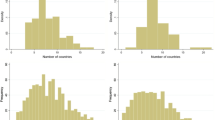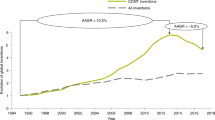Abstract
The development of climate-friendly technologies and its diffusion across countries is of key importance to slow climate change. This paper considers technologies in the mobile air-conditioning (MAC) sector which is a major contributor of fluorinated greenhouse gas emissions. Using patents as an indicator of innovations and patent citations as a proxy for knowledge flows, the inducement of new environmental and non-environmental technologies and knowledge diffusion within and across countries are analysed. The focus is on direct abatement of fluorinated greenhouse gases excluding energy efficiency improvements. We find that most environmental MAC patents originate from the US and Germany. Most knowledge flows take place within countries. Regarding cross-country flows most environmental knowledge diffuses from French and German patents, which is likely to be a result of regulatory activities in Europe and intensified research on environmentally benign MAC systems. Yet, this exchange of knowledge is not very intensive and stable so that the impact of EU regulations on US and Japanese patenting behaviour seems to be fairly weak.
Similar content being viewed by others
Notes
If firms innovate due to strict regulation at home and innovations diffuse internationally without policy diffusion, a “Porter-effect” occurs due to private benefits from the realized innovations (e.g. reduced energy costs, complementarity to other technologies). This may also depend on the lead market factors mentioned above. Porter and van der Linde (1995) have proposed that properly designed environmental regulations can induce innovation that more than offsets the cost of compliance (Porter-hypothesis). See Brännlund and Lundgren (2009a, b) for a discussion.
This is less so for component specialists producing multiple-use products like valves which may be used in MAC systems or in other applications.
It is also unclear to what extent these innovations amount to net environmental benefits as they may give rise to rebound effects by making air-conditioned driving more attractive than previously.
Despite the difficulties of classification we also ran regressions including “energy efficiency patents” (including controls for different energy costs), but could not find any conclusive evidence in the data.
Due to the data source we use this is only possible to some extent. For example, we cannot directly distinguish between citations added by the examiner and citations added by the inventor.
We therefore assume homogeneity between citation and knowledge flows. The reason for using applicants and not inventors is that there were too few inventors in PATSTAT that have country codes assigned to them (missing values).
As MAC systems are complex technological artefacts there is of course always the danger of missing relevant patents. We could have extracted patents from other IPC classes. For example, there is a wide range of technologies for measuring and testing purposes that may i.a. relate to MAC systems (e.g. G06). There are also other classes for air-conditioning in general (F24F) but not specifically for vehicles or other classes for vehicle propulsion and transmission technologies not directly related to air-conditioning (e.g. B60K). Similarly, there are relevant classes regarding the production of refrigerants (C09K5). However, these classes are not necessarily missed, since many patents are listed in more than one IPC class. Due to the time and effort of extracting and processing data from the large PATSTAT database we chose to restrict our search to four key classes. Using the publicly available Espacenet search profile with keywords like “air-conditioning AND vehicle” or “air-conditioning AND vehicle AND compressor” reveals that our search strategy is fairly robust (see http://worldwide.espacenet.com/advancedSearch?locale=en_EP).
Indirect abatement measures are not only more difficult to delimit and classify. Their environmental effects are also more dubious.
Backward citations do not suffer from truncation like (uncorrected) forward citations, since patents keep receiving citations over long periods of time, but we observe at best only the citation given up to the present (or the last year of the available data). Another potential problem that also affects backward citations is that the number of given citations has typically risen over time. However, it is difficult to tell if this is due to the real technological impact of the cited patents (combined with a rise in the rate of patenting) or a pure artifact of changes in patent examination practices. Therefore, we do not correct for this trend (see for a discussion Hall et al. 2001).
This approach is different from Popp (2006) who creates an artificial pool of potentially cited patents by considering only patents from the most cited US patent classifications for each of the pollution technologies considered.
Results are broadly similar and not reported here.
There are no self-citations among patents of individuals.
Popp (2006) estimates the likelihood of citation for various groups of patents controlling for factors affecting the likelihood of citation. He uses non-linear least squares based on a model developed by Jaffe and Trajtenberg (1999) and others. We also tried to estimate this kind of model, but our results did not converge. For a discussion of other model types in the innovation literature see also Peri (2005).
Results for this applicant-/firm-type analysis can be obtained from the authors on request. The analysis suggests that knowledge diffusion is not restricted to the major players in MAC systems (OEMs and MAC suppliers). Important knowledge is also produced and absorbed by firms and individuals that are not directly active in this market.
For sake of brevity the results are not reported in detail.
These results are taken from a closer look at the countries summarized under the rest of the world.
As explained in Sect. 4 this effect could also be due to differences in citation cultures between patent offices.
References
About Publishing Ltd (2004) The Global Market for Heating, Ventilation and Air Conditioning Systems, London, http://www.aboutpublishinggroup.com/
Braun FG et al (2010) Innovation in concentrating solar power technologies: a study drawing on patent data. Discussion Paper No. 994, German Institute for Economic Research (DIW), Berlin
Beise M (2001) Lead markets. Country-specific success factors of the global diffusion of innovations. Physica, Heidelberg
Beise M, Rennings K (2005) Lead markets and regulation: a framework for analyzing the international diffusion of environmental innovations. Ecol Econ 52:5–17
Brännlund R, Lundgren T (2009a) Environmental policy without costs? A review of the Porter hypothesis. Int Rev Environ Resour Econ 3:1–43
Brännlund R, Lundgren T (2009b) Environmental policy and profitability: evidence from Swedish industry. Environ Econ Policy Stud 12:59–78
Criscuolo P, Verspagen B (2008) Does it matter where patent citations come from? Inventor vs. examiner citations in European patents. Res Policy 37:1892–1908
Daly S (2006) Automotive air-conditioning and climate control systems. Elsevier, Oxford
Dechezleprêtre A et al (2011) Invention and transfer of climate change mitigation technologies: a global analysis. Rev Environ Econ Policy 5:109–130
Dekker T et al (2011) Inciting protocols. J Environ Econ Manag 64:45–67
De Vries FP, Withagen C (2005) Innovation and environmental stringency: the case of sulfur dioxide abatement, CentER discussion paper No. 2005–18, Tilburg University, The Netherlands
Garrone P, Piscitello L, Wang Y (2010) Energy innovation at the country level: the role of cross-country knowledge spillovers, working paper, 1 Dec 2010. Available at SSRN: http://ssrn.com/abstract=1661627
Goetzke F, Rave T, Triebswetter U (2012) Diffusion of environmental technologies: a patent citation analysis of glass melting and glass burners. Environ Econ Policy Stud 14:189–217
Gschrey B, Schwarz, W (2009) Projections of global emissions of fluorinated greenhouse gases in 2050, on behalf of the German Federal Environment Agency, Climate Change 17/2009, Berlin
Hall B, Jaffe A, Trajtenberg M (2001) The NBER patent citations data file: Lessons, insights and methodological tools, Working Paper 8498, National Bureau of Economic Research
Harhoff D et al (1999) Citation frequency and the value of patented inventions. Rev Econ Stat 81:511–515
Hicks JR (1932) The theory of wages. Macmillan, London
IPCC/TEAP (2005) Safeguarding the ozone layer and the global climate system: issues related to hydrofluorocarbons and perfluorocarbons, IPCC Special Reports
Jacob K et al (2005) Lead markets for environmental innovations. Physica, Heidelberg
Jaffe A, Trajtenberg M (1998) International knowledge flows: evidence from patent citations. NBER working paper # 6507, National Bureau of Economic Research, USA
Jaffe A, Trajtenberg M (1999) International knowledge flows: evidence from patent citations. Econ Innov New Technol 8:105–136
Jaffe A, Tratjenberg M, Henderson R (1993) Geographic localization of knowledge spillovers as evidenced by patent citations. Q J Econ 108:577–598
Jaffe A, Trajtenberg M, Fogarty MS (2000) Knowledge spillovers and patent citations: evidence from a survey of inventors. Am Econ Rev 90:215–218
Jaffe A, Newell R, Stavins R (2002) Environmental policy and technological change. Environ Resource Econ 22:41–69
Johnstone N, Haščič I, Popp D (2010) Renewable energy policies and technological innovation: evidence based on patent counts. Environ Resource Econ 45:133–155
Lanjouw JO, Mody A (1996) Innovation and the international diffusion of environmentally responsive technology. Res Policy 25:549–571
Managi S, Opaluch J, Jin D, Grigalunas TA (2004) Technological change and depletion in offshore oil and gas. J Environ Econ Manag 47:388–409
Meißner H-R, Jürgens R (2007) Zur Lage der deutschen Automobilzuliefererindustrie im Jahre 2007. Studie im Auftrag der Fraktion Die Linke
Newell RG, Jaffe AB, Stavins RN (1999) The induced innovation hypothesis and energy-saving technological change. Q J Econ 114:941–975
OECD (2009) OECD Patent Statistics Manual, Paris
Peri G (2005) Determinants of knowledge flows and their effect on innovation. Rev Econ Stat 87:308–322
Popp D (2006) International innovation and diffusion of air pollution control technologies: the effects of NOx and SO2 regulation in the US, Japan, and Germany. J Environ Econ Manag 51:46–71
Popp D, Newell R, Jaffe A (2009) Energy, the environment, and technological change. In: Hall B, Rosenberg N (eds) Handbook of economics of technical change. North-Holland, Oxford
Popp D, Haščič I, Mehd M (2011) Technology and the diffusion of renewable energy. Energy Econ 33(4):648–662
Porter ME, van der Linde C (1995) Toward a new conception of the environment-competitiveness relationship. J Econ Perspect 9:97–118
Rennings K, Rammer C (2011) The impact of regulation-driven environmental innovation on innovation success and firm performance. Ind Innov 18:255–283
Saint-Georges M, van Pottelsberghe de la Potterie B (2011) A quality index for patent systems. CEPR Discussion Paper Series No.8440, London
Umweltbundesamt (2004) Fluorinated Greenhouse Gases in Products and Processes, Technical Climate Protection Measures, Berlin
UNEP (2006) 2006 Report of the Refrigeration, Air-Conditioning and Heat Pumps Technical Options Committee. UNEP Nairobi, Ozone Secretariat
Verdolini E, Galeotti M (2011) At home and abroad: an empirical analysis of innovation and diffusion in energy-efficient technologies. J Environ Econ Manag 61:119–134
Verspagen B, Los B (2007) Technology spillovers and their impact on productivity. In: Hanusch H, Pyka A (eds) Elgar companion to neo-Schumpeterian economics. Edward Elgar, Cheltenham, UK, pp 574ff
Walz R, Schleich J (2009) The economics of climate policy: macroeconomic effects, structural adjustments, and technical change. Springer, Heidelberg
Author information
Authors and Affiliations
Corresponding author
About this article
Cite this article
Rave, T., Goetzke, F. Climate-friendly technologies in the mobile air-conditioning sector: a patent citation analysis. Environ Econ Policy Stud 15, 389–422 (2013). https://doi.org/10.1007/s10018-013-0069-3
Received:
Accepted:
Published:
Issue Date:
DOI: https://doi.org/10.1007/s10018-013-0069-3




